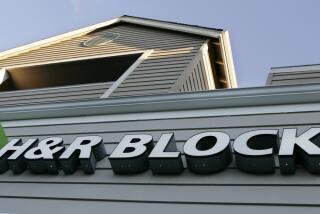Tax Break From AT&T;’s Breakup
QUESTION: Whatever became of the feud between AT&T; and the IRS over the tax consequences of the Bell System breakup? I bought AT&T;’s argument and treated the whole matter as a tax-free transaction even though the IRS warned us all not to do that. Did I goof? Or are they still fighting about it?--P. M.
ANSWER: You can expect a formal answer to your question in the mail any day now. On June 12, the Internal Revenue Service will begin mailing out explanations, claim forms and instructions to each of the several million shareholders who owned American Telephone & Telegraph stock on Dec. 30, 1983.
The mass mailing stems from a recent ruling by the Tax Court. It intervened at AT&T;’s request and ended up siding with the telecommunications giant. So, you called it correctly.
Since the IRS has agreed not to appeal the decision, the entire breakup will be treated as a tax-free transaction. In other words, none of the shares you received in the new regional companies will be taxed as dividends, contrary to the IRS’ instructions in 1984.
Those shareholders who did heed the IRS’ somewhat ominous letter back in 1984 are due for a nice surprise: tax refunds. How you go about claiming a refund will be laid out in the IRS package that you will receive later this month. The packet will include Notice 773, explaining how the Tax Court ruled and what that means to you; Form 1040X, on which you will claim your refund; instructions on filling out that form, and a return envelope.
The normal statute of limitations applies in this case. So, you have three years from the original due date to request a refund. For most taxpayers, that means the deadline is April 15, 1988.
By buying AT&T;’s argument, you’ve saved yourself a lot of paper work headaches. Not only will you not have to fill out forms for a refund, you won’t have an amended return to worry about.
Not so lucky are those who took the opposite tack. There will, no doubt, be especially loud groans from taxpayers who sold any of the stock in question after Dec. 31, 1983, and used the IRS’ approach in figuring the stock’s worth. They will be happy to hear that they are due a refund. But many also will have to take the time to recalculate their gain or loss from the sale and file amended returns.
To refresh readers’ memories, this dispute began Jan. 1, 1984, when the Bell System was broken up. Suddenly, there were seven regional companies plus AT&T;, and AT&T; shareholders were given shares in each. For each 10 shares of AT&T;, stockholders received one share of stock in each of the new regional companies. This raised a question: Would the distribution of new stock trigger a tax on the dividends? AT&T; said no. And the IRS agreed, with one exception. A small portion of the new Pacific Telesis stock would be taxable, the IRS argued, because of an earlier transaction involving a company that became a subsidiary of Pacific Telesis.
The bottom line: A taxable dividend equal to 39 cents for each share of AT&T; owned at the end of 1983. AT&T; objected and didn’t report this amount on the Form 1099s that it prepared for its shareholders in 1984. But the IRS held its ground. So, the matter went to the Tax Court. And AT&T; won.
Q: Despite all the headaches of figuring out that horribly complicated new form, I held on to my Keogh because it really serves my needs quite well. But now, my filing deadline is approaching again, and I’m once again trying to decide if I have the wherewithal to fill it out again. Has all of the complaining about this made the government rethink its Keogh requirements for people like me who don’t have any employees?--A. R.
A: In this, the widespread grumbling did have some effect. You still aren’t completely off the hook, as one-participant Keogh plan owners were until a year ago. But the registration statement you must file by July 31 for the 1985 calendar year will be considerably more simple than last year’s. (The deadline for fiscal year plans is the last day of the seventh month after the plan year ends.)
What you will file this year is Form 5500-R, a fairly simple two-page form. Last year, you were stuck filing the much more complicated, five-page 5500-C. This is true even for those sole participants who either started or terminated a Keogh in 1985. Keoghs are basically IRAs for the self-employed. They enable both employers and individual taxpayers with income from small businesses or moonlighting jobs to set aside part of their income into this tax-deferred retirement fund.
Until last year, those Keogh owners whose plans cover only themselves didn’t have to worry about filling out all of the complex forms that employers with Keoghs for their employees did. But in the interest of bringing some standardization to U.S. tax laws, the rules were changed. Suddenly, even those who squirreled away only a few hundred dollars from some moonlighting they did faced completing an immensely complicated five-page document really intended for employers with lots of employees.
As a result, thousands of protests poured into IRS and congressional offices. The IRS, bending somewhat to the complaints, extended the deadline to give sole participants a chance to figure out what they must do and, as often was the case, to hire a professional tax preparer. Nonetheless, thousands of Keogh participants unloaded their plans.
Debra Whitefield cannot answer mail individually but will respond in this column to financial questions of general interest. Do not telephone. Write to Money Talk, Los Angeles Times, 780 Third Ave., Suite 3801, New York, N.Y. 10017.
More to Read
Inside the business of entertainment
The Wide Shot brings you news, analysis and insights on everything from streaming wars to production — and what it all means for the future.
You may occasionally receive promotional content from the Los Angeles Times.










